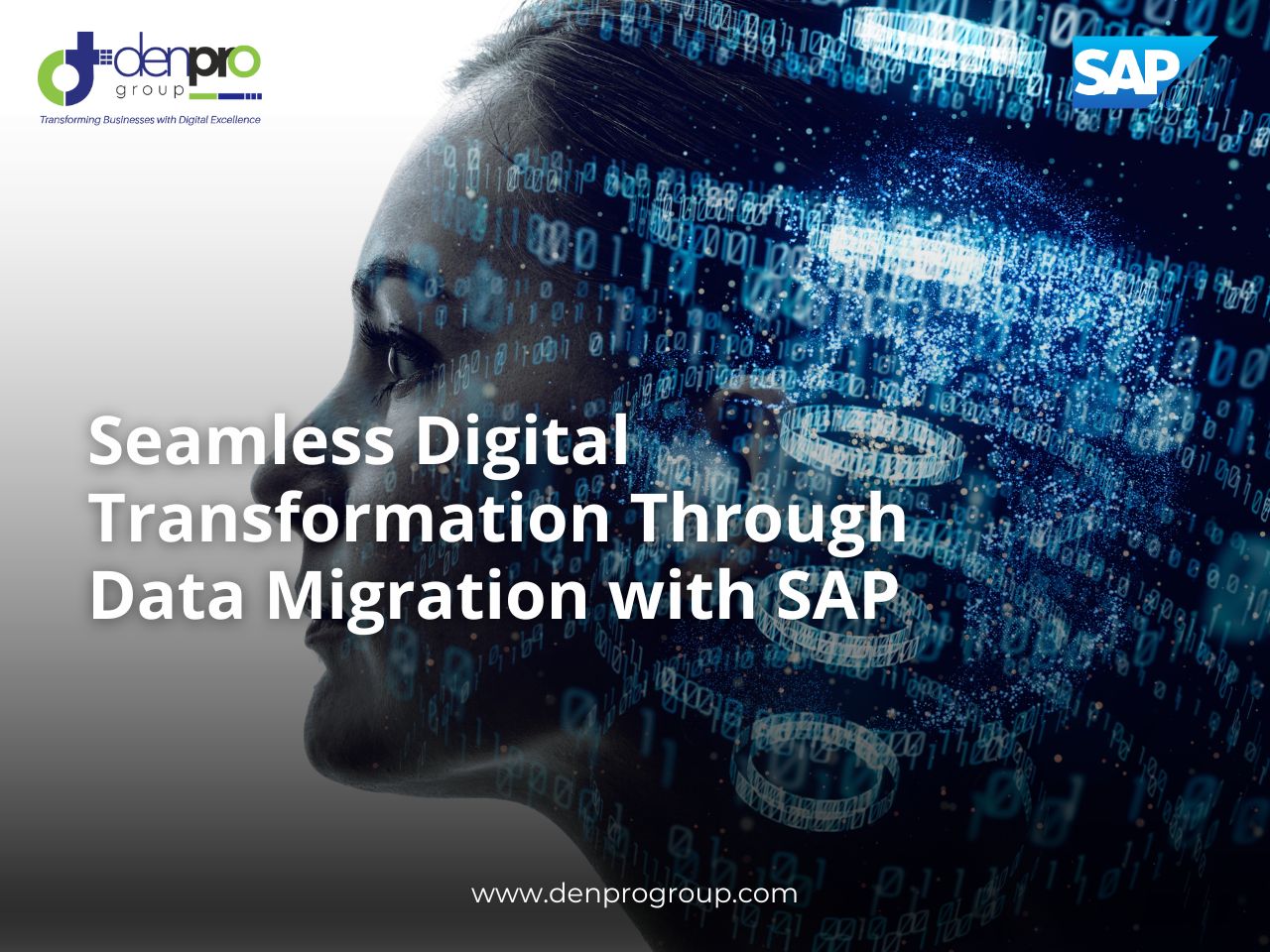
Seamless Digital Transformation Through Data Migration with SAP
Data is an organization’s primary asset in the hyperconnected world of today. Businesses can improve efficiency, make intelligent choices, and innovate for the future using the support of accurate, straightforward, and secure data. Data migration with SAP is growing into an important component in updating corporate procedures as Saudi Arabian corporations embrace digital transformation in keeping with Vision 2030.
Data migration needs to happen to make sure that every company’s activities, whether the firm plans on moving to the cloud, upgrading to SAP S/4HANA, or shifting from legacy systems, perform properly in the new environment. The conditions for long-term growth and operational excellence can be established by a complete migration, however a hasty transfer may lead to oversights, disruptions, and inefficiencies.
This blog addresses what data migration with SAP includes, its relevance for Saudi companies, the purpose of educated consultants, and why success requires utilising trustworthy SAP Implementation Companies in Saudi Arabia and best SAP Migration Services in Saudi Arabia.
Managing Data Migration with SAP
Data migration implies the process of changing business-critical data from one system to another. Data migration with SAP is the process of transferring data from ancient ERP platforms or legacy systems to SAP’s newer services, for instance SAP S/4HANA or SAP Business Suite on HANA.
Transferring files is only a first stage in the process; extensive preparation, cleanup, validation, and testing must happen for maintaining data integrity and complete realignment of the new system with company processes.
In general, the migration contains a range of data sorts, like this one:
1. Customer information, vendor details, product advertisements, and worker files are examples of this master data.
2. Purchase orders, invoices, sales orders, including financial entries are an instance of transactional data.
3. Workflows, system settings, including business rules are illustrations for configuration data.
4. Documents from archives that assist for reporting, audits, and compliance are recognised as historical data.
The Impact of Data Migration with SAP
1. Precision and Dependability
Accurate data is mandatory for company choices. Reliability in reporting, analytics, and everyday operations is made possible by clean and well-migrated data.
2. Respect to Guidelines
Saudi companies are governed by strong standards of compliance, particularly those operating in the government, healthcare, and banking industries. Records that agree to national and international regulatory standards will be ensured by proper data migration.
3. Continuity of Activities
Operations disruptions during the change might be significant. A proper migration method promises an effortless move and minimizes downtime.
4. Unlocking the Full Potential of SAP
Scalability, automation, and real-time insights are wherein SAP systems genuinely emerge. Businesses are able to maximise these tools if the move has been executed accurately.
5. Adopting Vision 2030
Data migration lets Saudi Arabia realise its Vision 2030 commitment to supporting innovation, efficiency, and diversification by boosting data-driven decision-making.
Data Migration Problems
Despite there being plenty of benefits, sometimes there are downsides associated with employing SAP for Data Migration. Frequent challenges include those that follow:
1. Limitations with Data Quality:
Outdated, inconsistent, or duplicate data frequently arise in legacy systems.
2. Complexity of Large Data Sets:
Ensuring validity during shipment is an inconvenience to companies holding millions of records.
3. Integration with Other Systems:
Corporations frequently use a variety of software programmes, all of which must work together with SAP smooth issues.
4. Risks of Downtime:
Lack of planning could contribute to lengthy interruptions and output reductions.
5. Change management:
During a move, hiring managers must get used to novel processes and structures.
Excellent planning and sound direction is required for getting past these difficulties.
Aspects of SAP Data Migration
1. Planning and Appraisal
Organisations examine the present situation of their data, find any holes in it, and establish particular targets. Defining the scope, timelines, and resources is a component to this procedure.
2. Data Processing
Duplicates, oversights, and needless entries have been reduced by organisation, inspection, and cleanup of the data. Migration threats reduce by clean data.
3. Transformation and Mapping of Data
The new SAP environment is mapped to legacy data structures. In this regard, SAP’s new formats have to correspond with the customer data in past ERP systems.
4. Application of Migration
Data is safely transported into the SAP system using specialist tools. To reduce interruption, this method might be conducted out in sections.
5. Testing and Validation
Extensive testing is implemented to establish the integrity and accuracy in the data. Results are examined by stakeholders to ensure that they have been ready for launch.
6. Support and Go-Live
The new SAP system goes live following verification. Post-migration counselling ensures that any issues are immediately fixed and that individuals adjust to minimal difficulty.
SAP Data Migration Tools
SAP delivers an assortment of technologies and tools to make migration quicker and guarantee accuracy:
1. Data extraction, transformation, and loading (ETL) has been made easier by SAP Data Services (SAP DS).
2. The software giant’s S/4HANA Migration Cockpit contains controlled tools and templates for organised migration.
3. SAP Landscape Transformation (SAP LT): For data transformation and real-time replication.
4. Third-Party methods: For sophisticated or hybrid migration efforts, a lot of institutions use external solutions.
Corporations can assure excellent data integrity and avoid laborious processes by employing these technologies.
The Function of Saudi Arabia’s SAP Migration Services
Organisations everywhere in the Kingdom comprehend that migration is more than just a technical exercise; it’s an organisational choice. By cooperating with competent Saudi Arabian SAP Migration Services providers, business could minimise risks, manage complexity, and streamline change.
These sellers of services provide:
1. Entire Migration Service:
From preparing to afterwards adjustments.
2. Industry Understanding:
Solutions designed exclusively for Saudi industries, covering manufacturing, retail, healthcare, and oil & gas.
3. Cloud Integration:
Advise on establishing cloud platforms that reduce IT expenditures and enhance flexibility.
4. Linking security:
Making certain the exported data complies using world standards and Saudi laws.
Businesses could reduce interruption and enhance the beneficial effects of migration by employing skilled local partners.
The Function of Saudi Arabian SAP Implementation Companies
Reputable Saudi Arabian SAP implementation firms do more than simply just migrate. They offer the technical expertise necessary in setting up SAP systems in fulfilment of company demands and provide seamless interaction with existent programmes.
Apparently their contributions are these:
1. Updating SAP modules for supply chain, logistics, finance, and recruitment.
2. Offering support with change management and training.
3. Executing thorough inspections to confirm system dependability.
4. Supplying post-implementation alternatives to further enhancement.
Partnership with such corporations helps Saudi Arabian institutions gain long-term scalability and quicker returns on expenditure.
Best Practices for Successful Data Migration
Using the suggested procedures can greatly enhance results when enterprises preparing a Data migration using SAP:
1. Start with Specific Goals:
Establish what success signifies in terms of system capabilities, cost savings, and efficiency.
2. Involve Key Stakeholders:
Engage leadership, IT teams, and end-users early to ensure alignment.
3. Make Data Quality a top concern:
Precise and efficient technologies are dependent upon clean data.
4. Use a Phased Approach:
For fewer interruptions, migrate data incrementally.
5. Perform Detailed Testing:
Confirm the accuracy and integrity just before launch.
6. Invest in Training:
Educate workers the skills necessary for successfully using new SAP systems.
7. Use Competent Consultants:
For challenging migration initiatives, rely on professional sources.
Successful Migration in Saudi Arabia as a Model Example
Outdated ERP systems generated operational difficulties for a Jeddah retail company. Data was not accurate, reporting wasn’t timely, and supply chain visibility was not sufficient. For the project to move to SAP S/4HANA, the company employed one of the top SAP implementation companies in Saudi Arabia.
Through using SAP for moving data in an ordered manner, an organisation was able to:
1. 40% faster reporting.
2. 30% lower errors in inventory management.
3. Insights regarding client tastes in real time.
4. Greater commitment to national tax codes.
The move put the corporation in a greater position to compete in the competitive Saudi department store sector.
Data Migration’s Future in Saudi Arabia
The desire for data migration services will only increase as digital transformation gathers increasing steam. Among the main trends shaping the future are as follows:
1. Growing Cloud Migration Adoption:
Corporations will be migrating rapidly to cloud and hybrid environments.
2. AI-Powered Data Cleaning:
Technologies that use machine learning will increase data preparation speed and accuracy.
3. Real-Time Migration:
Downtime will be eliminated with tools which permit live data transmission.
4. Emphasise on Data Security:
Corporations will give secure migration operations the greatest importance as a result of tougher regulations.
Organisations who adopt these trends will be in an advantageous place to succeed in the aggressive Saudi market.
One important aspect of Saudi organisations’ digital transformation is data migration using SAP. Using efficient, reliable, and efficient data transfer, organisations can optimise the abilities of SAP systems, obtain real-time insights, and reach long-term scalability.
By cooperating with respected SAP Implementation Companies as well as experienced SAP Migration Services providers in Saudi Arabia, business may effectively conquer migration issues and execute smooth transitions. Innovation, efficiency, and sustainable growth will keep counting on efficient data migration as the Kingdom targets Vision 2030.







